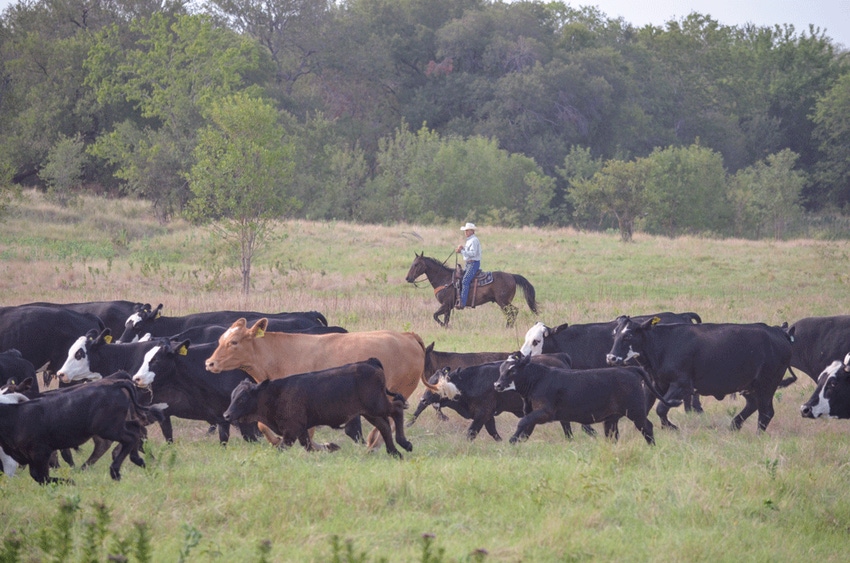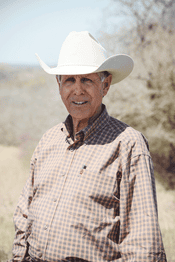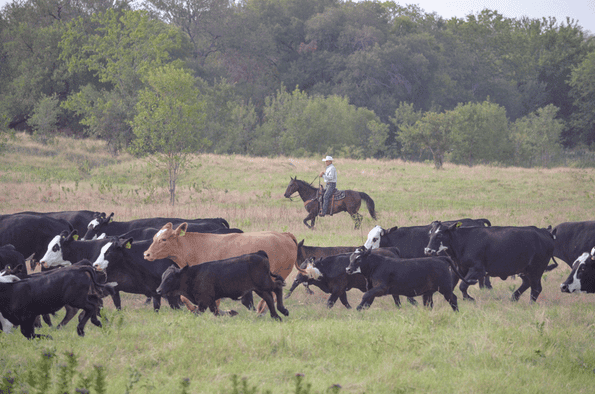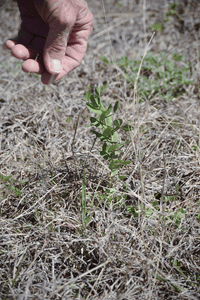Better water, better beef and better beer?
Focus first on water quality and everyone benefits, even beer drinkers
February 11, 2016

Stroll the pastures on the 77 Ranch, cast a practiced eye on the cattle grazing there and you could come away with the idea that this is a ranch that does the little things very well.
You would be right.
“It all boils down to water,” says Gary Price, who along with his wife, Sue, owns the 77 Ranch at Blooming Grove, Texas. “How we manage the rainwater we receive is the key to everything we do.
"We can’t just pray for rain and everything will be fine; we have to be ready to receive the rain we do get," Gary says. “If we plan right, that rain will grow grass, water livestock, and we won’t lose any of it before it has served its purpose on this ranch. Our water ends up being drinking water downstream in Livingston, or in Richland Chambers Lake to be piped back to Fort Worth.”
Or, more importantly to some, at least, it ends up flowing into the MillerCoors brewery in Fort Worth.
The 77 Ranch lies in the Chambers Creek watershed, an important tributary of the Trinity River that drains an area of more than 18,000 square miles of mostly private land and supports the primary water needs for over 40% of the state's population. Water that millions of Texans drink comes from raindrops that fall on private land, making good stewardship of this land beneficial to urban populations and critical to their community water supplies.
Group effort at the grassroots

Gary Price, 77 Ranch
Major municipal water suppliers such as Tarrant Regional Water District (TRWD), which supplies water for Fort Worth residents, see it the same way. They can save hundreds of thousands of dollars in water treatment costs if they work with landowners in targeted watersheds to filter soil particles and other pollutants out of the water before it gets to the city’s reservoirs.
Through the local soil and water conservation districts, they offer piggyback on federal, state and local programs to offer incentive payments to landowners for applying practices that contribute to reduced erosion and sedimentation. “This is an opportunity for us to show urban areas what landowners can do for their water,” Gary says.
In 2012, the Prices enrolled a portion of their land in the USDA Natural Resources Conservation Service (NRCS) National Water Quality Initiative, which was offered in their Chambers Creek watershed, a tributary to Richland-Chambers Reservoir. This 152,000-acre subwatershed of the Trinity River Basin supplies a large portion of the water for 1.8 million residents.
The initiative works in priority watersheds to help producers with planning and financial assistance to implement conservation and management practices to control and trap nutrient and manure runoff. Conservation practices such as cover crops, filter strips and terraces can be applied through this program.
Positive changes are brewing
Heavy hitters in the corporate world, like MillerCoors, are buying into the idea as well. The company’s Tarrant County brewery depends on a fresh, quality water supply. It’s willing to help landowners like the Prices deliver filtered water to the brewery.
The company’s Fort Worth brewery lies in the Trinity River Watershed and receives the majority of its water from the city of Fort Worth via the Tarrant Regional Water District.
“All beer is about 94% to 96% water, and good beer starts with good water,” explains Lairy Johnson, environmental sustainability engineer for MillerCoors, Fort Worth. “It is in our best interest to make sure the best quality of water comes back to our brewery to make our great products.”
Since 2012, MillerCoors has put up $385,000 in incentive payments and technical assistance to help landowners manage their resources wisely.

BEEF Seedstock 100 List
Looking for a new seedstock provider? Use our UPDATED Seedstock 100 listing to find the largest bull sellers in the U.S. Browse the list here.
“This is really a revolutionary idea,” Gary says. “But it makes sense. We aren’t just providing beef for America — we are providing other things like clean air and clean water, and people are willing to pay for that.”
Their focus is clear
Conservation professionals across the country have taken notice of the Prices’ resource management efforts.
The National Cattlemen’s Beef Association (NCBA) awarded the Prices the association’s highest ranch management honor in 2013, the National Environmental Stewardship Award. In 2011, the Texas Section, Society for Range Management and the Texas and Southwestern Cattle Raisers Association recognized the Prices with the Outstanding Rangeland Steward Award. Several years prior to that, Texas Parks and Wildlife and the Sand County Foundation honored them with the Aldo Leopold Conservation Award and Lone Star Land Steward award.
Conservative from the start
Gary grew up not far from where he now ranches, working on area ranches every chance he got. Local rancher Lee Lowe took a liking to the young Gary and became a mentor to him. When Lowe retired, he offered Gary the chance to purchase his 77 Ranch, a life-changing opportunity the Prices are grateful for 36 years later.
One of the Prices’ first steps was to visit the local NRCS and soil and water conservation district office to work with the staff to develop a conservation plan, or land management plan, for the ranch.

Breathtaking photos of winter on the ranch
The first snow hit parts of the Midwest this week. Mentally prepare for the winter wonderland with these stunning photos. See photos here.
Through their conservation plan, the Prices have implemented land management practices such as thinning mesquite to make more land available for grazing, planting native grasses for increased ground cover and grass production, and designing stock ponds for a more sustainable supply of water for livestock and wildlife.
“We aren’t here to conquer the land, but see what it is trying to tell me to make a living off it,” Gary says.
They must be doing something right. Throughout the severe drought of 2011 and 2012, the 77 Ranch never ran out of water, and the Prices never had to buy supplemental feed for their cattle.

Through their conservation plan, Gary and Sue Price have implemented land management practices such as thinning mesquite to make more land available for grazing, planting native grasses for increased groundcover and grass production, and designing stock ponds for a more sustainable supply of water for livestock and wildlife. Photo courtesy of NCBA
“With good management practices, you buy yourself time and flexibility, and that keeps you sustainable,” Gary says. “We stock according to what the land tells us it can take.”
Sometimes that means the Prices reduce herd numbers, but never to the point of de-stocking. They view cattle as a tool to help keep pastures managed for optimum health.
“I think of each stand of grass like a pecan tree,” Gary explains. “You don’t want to go in there and chop the tree down; take care of the tree, and then harvest your pecans and nurture it until the next harvest. It’s the same with grass.”
Gary stresses the importance of being flexible. “There are going to be droughts and market changes,” he says. “You can’t be that vulnerable to bad news. You need to spread your resources out to protect yourself.”
Gary says it is important to stay “the course of balance,” because as he says, “The turtle won the race, not the rabbit.”
Managed for health
Gary and Sue both enjoy tending to the ranch and the livestock, often checking pastures together.

Close attention to the plant community in the pastures at the 77 Ranch has allowed Gary and Sue Price to increase the grazing capacity of their ranch while helping the pastures serve as a sponge for rainfall.
“We have to conserve everything from soil to sunlight to grass,” Gary says. “To convert that to income, we have to have a good product to stay sustainable. Every piece of the puzzle fits together.
“The irony is not lost on me that the more you know, the more you realize you don’t know,” Gary says, shaking his head in amazement. “When it comes to soil health and using plants to increase soil health, I think we are only scratching the surface.”
The Prices recently worked with the NRCS office to drill winter cover crops of red clover and Austrian winter peas into their fallow Klein grass and KR bluestem pastures. The cover-crop plants should leave behind valuable nutrients that will act as fertilizer and soil health enhancers. They’ll also improve water storage the main grass crops can use during the growing season.
“Growing our own fertilizer like this gives us a lot more control over our inputs — both in terms of chemicals and money. I think this is a big step in the right direction,” Gary says.
Dee Ann Littlefield is an NRCS public affairs specialist based in Henrietta, Texas.
You might also like:
Does it really take six years to cover your costs on a cow? NO
60 stunning photos that showcase ranch work ethics
Grass-Fed Vs Grain-Fed Ground Beef: No Difference In Healthfulness
Get ready for an interesting year in the cattle business
PETA activist blasts FFA members; it's time to set the record straight
7 ranching operations awarded top honors for stewardship, sustainability
You May Also Like



